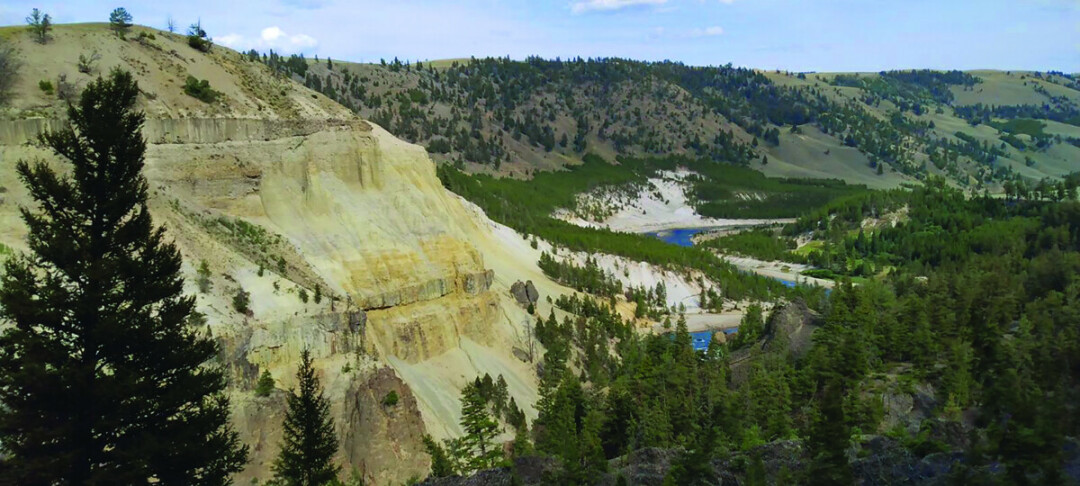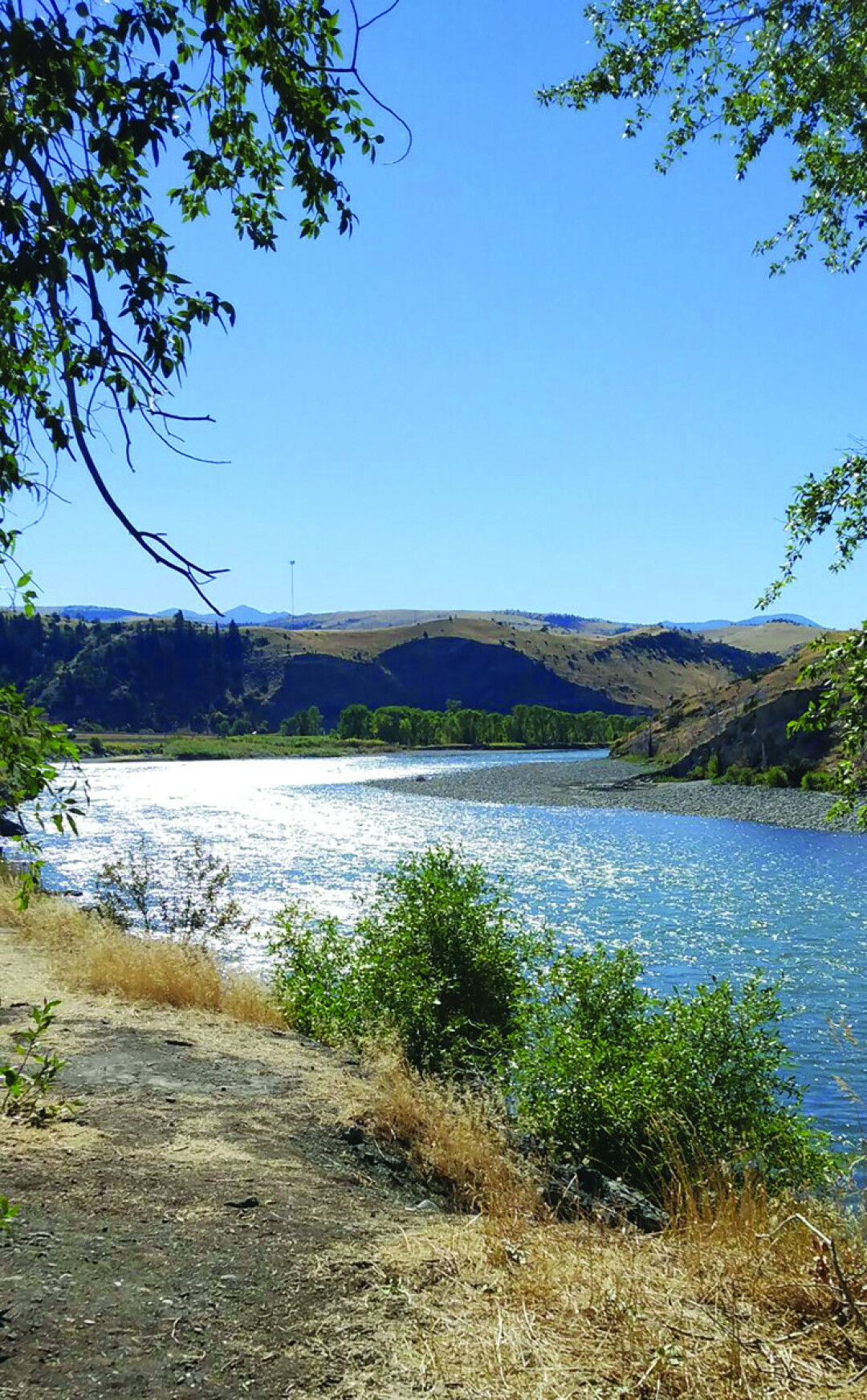La Roche Jaune: A Priceless Montana Watersource

On a sandstone bluff just west of the town of Miles City, a gnarled Mountain Rocky Juniper patriarch stands firmly entrenched in the rocky soil. The juniper has been standing for more than three centuries. To the unperceptive eye, the juniper equates to no more than a withered block of wood of questionable economic value. To the discerning eye, the juniper portrays a library of decades of vivid climatic snapshot recordings ingrained in its historical tree rings; recordings of a vast, big sky country — a land shifting between hot and cold, wet and dry, durable and fragile, beautiful and bizarre. During its lengthy lifespan, the juniper was also witness to many historical river events that, unfortunately, could not be recorded in its concentric tree rings.
The Yellowstone, a lengthy and pulsating artery that stitches its way 670 miles to its confluence with the Missouri, remains unshackled by major dams from its source in the high country of northwestern Wyoming. During its passage, it nourishes riparian zones, irrigates croplands, furnishes municipal water needs, powers industry, provides bottomlands habitat for a diversity of wildlife, sustains abundant and diversified fish species, and provides unrivaled recreation opportunities. The river flows as a symphony of elaborate and ordered entanglements, physical and chemical components blended with biological ones — a river with a complete ecosystem, constantly changing Nature’s age-old rhythms. A sense of historical time lies thick and heavy on such a river setting.
To many Montanans, the Yellowstone is labeled by a simple dichotomy known as either the upper or lower Yellowstone. The Columbus, Laurel and Billings reaches of the Yellowstone represent transition water, with neither the clarity of the upper reach, nor the rolling clouds of silt in the lower section. The lower Yellowstone is a different kind of river from the upper reaches, but it’s just as true and genuine as where it sprang from in the high country. Perhaps even more genuine, for it has lost the look and color of fir, sky, and snow, and is now its own river. Once you pass the mouth of the Bighorn River, you enter the lower Yellowstone, which is distinct from the upper river in size, shape and character. Floaters who know the upper and lower reaches of the river recognize it as the kind of country that can make a person feel small. Water formed its landscape in the beds of ancient Cretaceous seas. Water sculptured its rocks, gnawed mazes of steep-walled coulees and alluvial valleys, carved its banks and stripped away its flesh, leaving a sea of jumbled geological skeletons. In such places a floater can encounter a haunting and serene quiet, a place where s/he can feel at home with ancient and mysterious rhythms, a place that offers a museum of living complexities.
Many writers have attempted to describe this unique, twisting ribbon of water that runs boldly through a dissected country that lifts in great swells to the open horizons. Nobody has fully succeeded. You have to float the river to truly experience what it has to offer. By doing so, the impressions do not arrive secondhand through the medium of words. Instead, the river speaks, using words from long ago — as if it were carrying you through a time warp in which past and present are joined. Only then can you fully comprehend that the Yellowstone is more than moving water, more than a source of energy.
The Yellowstone has many attributes. We know it well for its unrivaled recreation for floaters, anglers, hunters, and agate pickers, for its sweeping scenery, irrigated richness, diverse and complex ecosystem, wandering rangelands, and for its cities and towns, which still blend harmoniously with a unique river that is more than a simple system of flowing water. The Yellowstone represents one of the last major rivers in the continental United States that functions as a free-flowing system and remains attuned to its surrounding environment. Although the historical colors have faded a little, the French “La Roche Jaune” (Yellow Rock) still remains a buckskin river, a river constantly changing in nature’s age-old rhythms.
The Yellowstone is a big river, in some spots an awesome one, a river that pours almost four trillion gallons a year into the Missouri. In terms of scenery, it represents a diversity of striking beauty. Which spectacular and scenic vista of the Yellowstone one prefers depends upon past exposure to the river. For some, it’s the cool, upper reaches with their gin-colored tributaries and blue-ribbon cutthroat and rainbow fisheries running through Paradise Valley. For others, it’s a wide river bottom in eastern Montana with wind-swept yellow rimrocks and bluffs. Geologically, it tells a fascinating story of eons of sculpting by wind, water and other geological forces. Archeologically, the area possesses many sites representing the aboriginal culture of the Plains Indians. Paleontologically, it contains a rich and varied graveyard of fossils. In terms of wildlife, a diverse corridor of habitats provides for a wide array of plant and animal species. Aesthetically, it has the power to rekindle many questions, memories, and hopes.
For history buffs, the Yellowstone offers a wide selection of historical landmarks. History springs to life at every turn in the river. It reverberates through shallow coulees where buffalo once thundered toward distant horizons. It rides the transcontinental railroad, where trains rattled east with cattle for meat-hungry markets and returned with land-hungry homesteaders. History follows the twisting Yellowstone, highway for William Clark of the Lewis and Clark expedition. It still, seemingly, hears the whistle of steamboats that once plied the great river with their cargo of buffalo hides and pioneers. History stares somberly from the sightless windows of abandoned farmsteads, remnants of homesteader’s dreams broken by drought, bank failures, and economic depression years.
In past years, the river has been subjected to numerous assaults. How Montanans responded in the past years to changing values and priorities of the Yellowstone River is a lengthy story of federal attempts to dam the Yellowstone, of state water wars, river abuse, climate change impacts, evolving public values, scientific aquatic investigations, and political state and federal activism.
Decades Of River Abuse And New Climate Change Threats
When Montana went from a frontier to a booming and profitable industrial economy, the Yellowstone River was subjected to many abuses, including industrial and domestic pollution, dredging, riprapping, channel alterations, shoreline dikes (levees), oil spills from ruptured pipe lines. In 2023, a bridge collapse resulted in a train derailment, plunging ten railroad cars into the Yellowstone near Columbus, spilling nearly 500,000 pounds of liquid asphalt into the river, causing considerable contamination to the River’s ecosystem.
The threat of aquatic invasive species such as zebra mussels and their close relative, quagga mussels, continues to alarm those who help manage Montana’s aquatic resources.
Climate change, a grim new reality to river ecosystems, surfaced in August 2016 with a massive Yellowstone River Mountain Whitefish kill (plus small numbers of other fish species), resulting in a closure to recreational use from Gardiner to Big Timber. When cooler temperatures prevailed in September, the 183-mile closure was reopened.
The causative agent documented was a microscopic, capsule-shaped parasite that thrives in warm water and low flows. Scorching summer temperatures raised Yellowstone water temperatures about 15 degrees above normal for trout and whitefish. Parasitic spores invading through the gills cause the deadly kidney disease. Recent outbreaks have also occurred in Washington, Oregon and Idaho. The magnitude of this kill, fish biologists agreed, was unprecedented for the region, and does not appear to be a one-time event. The documented trend of rising temperatures in the region’s rivers over the last two decades is a factor in a complex equation, and the Yellowstone fish kill served as a red-flag teachable lesson — a warning for future disasters pending with increasing global temperatures. Without human-caused climate change, scientists maintain that extreme temperature records would not be broken nearly as frequently as has happened in recent years.
In June 2022, extreme flooding roiled southwest Montana and temporarily closed Yellowstone National Park. Water tore out Gardiner’s sewage line, and toppled bridges. The Yellowstone carved new channels and eroded banks, causing a house to fall into the river and float away. Climate scientists predict these one-in-500-year flood events will only become more frequent with rising temperatures.
Centuries have passed since the juniper’s life support system began. As a product of a northern plains environment, the patriarch of the Yellowstone Basin has witnessed Montana’s growth, expansion, progress and change; it has seen its share of Americans who are impatient with traditions, ideologies and the status quo, and who are eager to explore the next evolutionary chapter of the river. We can be assured that Montanans from all quarters will be in a full-response mode to protect this most precious water resource, especially during the current trend of climate change.
In reference to future years, Montana and other out-of-state water users, among whom the spirit of understanding and generosity has not been wholly absent – will have to walk different and sometimes difficult paths to find solutions for the numerous challenges that will confront the Yellowstone – paths based on science, mutual sacrifice, and cooperation. For now, the free-flowing Yellowstone flows on with its own life and unfettered spirit.

